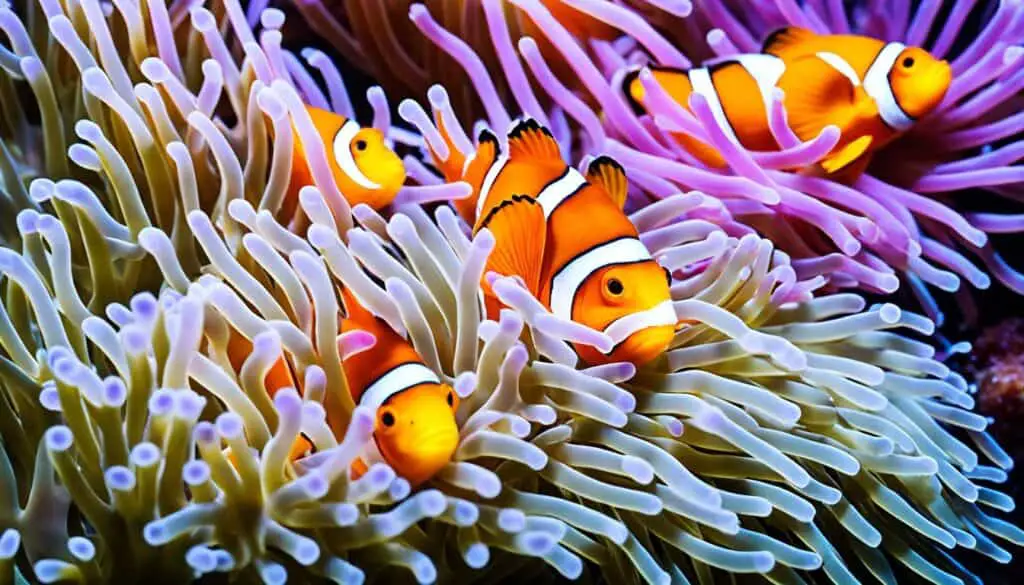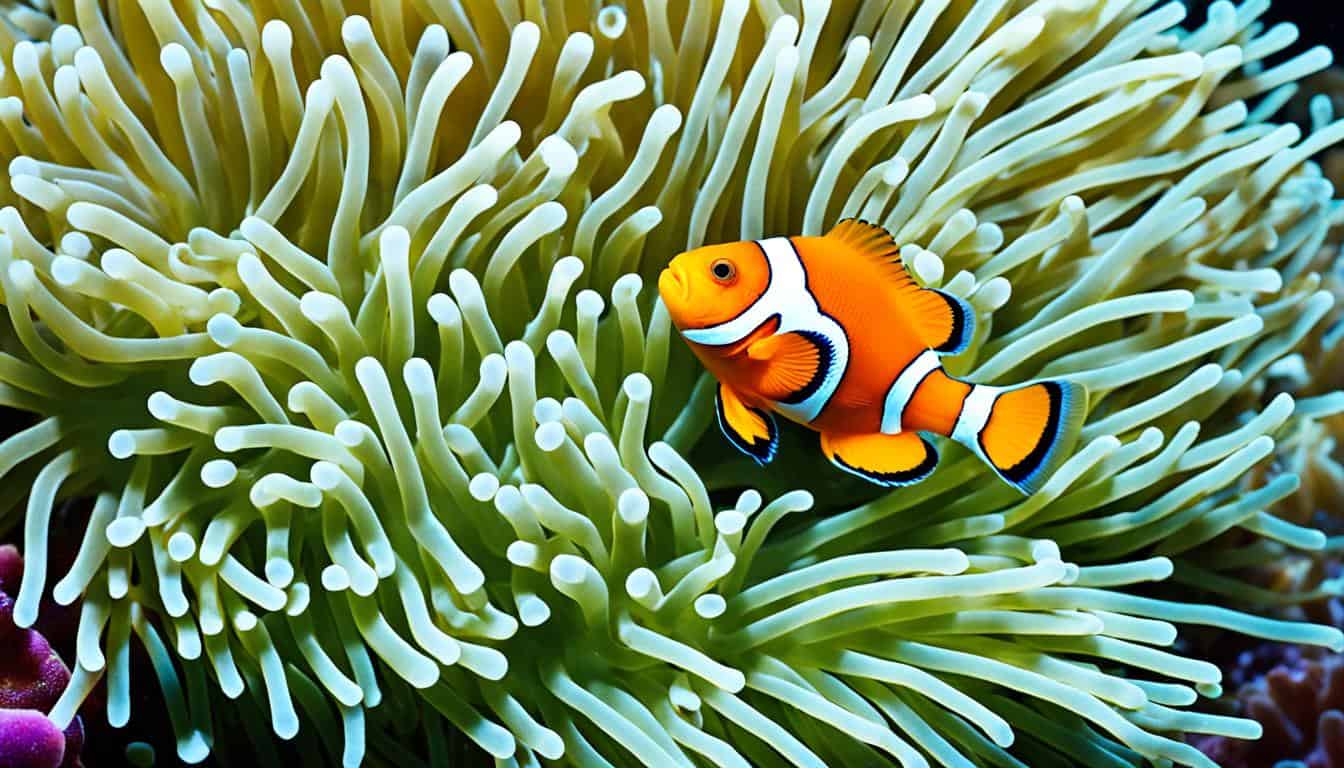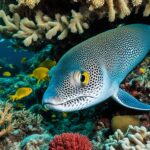The relationship between clownfish and anemones is a perfect example of mutualism. These colorful fish live safely in the anemones’ protective tentacles. Anemones look like plants but are actually predators with stinging tentacles. Clownfish have a special mucus layer that protects them from these stings.
This special bond between clownfish and anemones helps both species survive. It has also made them popular in aquariums and in movies and TV shows.
Understanding the Clownfish and Anemone Relationship
The bond between clownfish and sea anemones is a perfect example of mutualism. Both species gain a lot from each other. Clownfish live safely in the anemones’ tentacles, avoiding predators. In return, they help the anemones grow by bringing nutrients like ammonia.
The Basics of Mutualism
Clownfish stay safe in the anemones’ stinging tentacles. They bring food waste that helps the anemones grow. This helps both the clownfish and the anemones to survive and thrive in the ocean.
Iconic Nature of the Partnership
This partnership is well-known and loved by many. It shows how clownfish behave near anemones in special ways. For example, they do a ‘dance’ to get used to the tentacles. These behaviors show how well adapted clownfish are to living in anemones, benefiting both species.
How do clownfish interact with anemones?
The relationship between clownfish and anemones is special. They help each other out in many ways. Clownfish get safe from predators, and anemones get protected from threats too.
The Protective Benefits for Clownfish
Clownfish live in anemones for safety from predators. The anemone’s tentacles keep away fish that might want to eat them. This makes the anemone a safe place for clownfish to hunt and hide when needed.
This shows how well clownfish and anemones work together. Both get something good from their relationship.
Anemone Protection from Predators
Clownfish help keep their anemones safe in return for a home. They chase away fish that might eat the anemone. This helps the anemone stay healthy and strong.
This shows how clownfish and anemones help each other. They both get a lot of benefits from being together.
Clownfish Behavior Near Anemones
Clownfish and anemones have a special relationship that helps both species survive. Clownfish know how to move around their anemone homes to stay safe. This helps them live longer.
Navigating Around Their Hosts
Clownfish move carefully when they get close to their anemone. They touch the tentacles to get used to the area. This makes them feel safe and also helps them get a special mucus coat.
This mucus protects them from the anemone’s sting. It shows how closely these two species work together.
Feeding Dynamics
Clownfish and anemones also work together when they eat. Clownfish eat leftovers from the anemone’s meals. In return, they give back nutrients to the anemone.
This helps both species do well. The clownfish’s safe home in the anemone makes it easier for them to find food. This shows how these two species depend on each other.
| Interaction Type | Clownfish Role | Anemone Role |
|---|---|---|
| Exploratory Movements | Acclimatization | Providing Safety |
| Feeding Interactions | Consuming Leftovers | Nutritional Support |
| Protective Mechanisms | Developing Mucus Coat | Defending from Predators |
Clownfish Protection from Anemones
Clownfish live in a special relationship with anemones, which protects them. This shows how they have evolved to survive in their colorful ocean home.
Resistance to Nematocyst Stings
Clownfish have a special way to avoid getting stung by anemones. They have a skin coating that stops the tiny stinging cells from working. This is key to their survival.
They can even trick the anemone into thinking they are part of it. This makes them safer inside their home.
The Role of Mucus
The mucus on their skin does more than just protect them. It helps them live well with anemones. When they are near anemones, their mucus changes to help them connect better with their hosts.
This special connection makes a safe place for clownfish. It also lowers the risks from the anemones’ stings.

The Anemonefish-Anemone Relationship Explained
The relationship between anemonefish and anemones is truly fascinating. They live together, offering safety and nutrients to each other. Clownfish find a safe home in anemones, which helps both species thrive in the ocean.
Safe Habitat for Clownfish
Clownfish hide in the anemone’s tentacles to stay safe from predators. The anemone’s stinging cells keep away threats. Clownfish have a special mucus that protects them from the anemone’s sting.
This special adaptation is key to their survival and the success of their relationship.
Mutual Feeding Benefits
Clownfish and anemones help each other out in more ways than one. Clownfish keep the anemone healthy by adding nutrients to the water. This helps the anemone grow and reproduce, which is good for both.
This sharing of nutrients makes their relationship strong and beneficial for everyone involved.
Clownfish Shelter in Anemones
Anemones are amazing structures that offer a perfect home for clownfish. They have a special relationship with clownfish. The anemone’s tentacles protect the clownfish from big predators. This makes their ocean home safe and stable.
For clownfish, living in an anemone means they are safe and have plenty of food. This place is ideal for them.
Why Anemones are Ideal Homes
Clownfish love living in anemones because they are safe there. They can’t feel the sting of the anemone’s tentacles thanks to a special mucus layer. This lets them enjoy the benefits of living in an anemone.
They get warmth, food, and are safe from danger. Living close to anemones is good for their survival.
Reproductive Practices of Clownfish
Clownfish have special ways of reproducing that help them succeed. They lay their eggs near their anemone home. This keeps the eggs safe from predators.
This shows how important it is for clownfish to have a safe place to raise their young. The anemone’s tentacles keep predators away. This highlights the strong bond between clownfish and anemones.
FAQ
How do clownfish interact with anemones?
Clownfish and anemones have a mutualistic relationship. Clownfish help by bringing nutrients through waste. In return, they get protection from predators inside the anemone’s tentacles.
What benefits do clownfish get from living in anemones?
Living in anemones gives clownfish protection and a safe place. The anemone’s tentacles keep away predators. This lets the clownfish flourish in their ocean home.
How do clownfish protect their anemone hosts?
Clownfish defend their anemones by chasing away fish that might eat them. This keeps the anemone healthy and looking good.
What behaviors do clownfish display around anemones?
Near anemones, clownfish move around to get used to the tentacles. They rub against them to build a protective mucus layer. This makes them safer.
How do clownfish resist the stings from anemones?
Clownfish have a special mucus on their skin. This stops the anemone’s stinging cells from firing. So, they can safely live among the tentacles.
Why do clownfish lay eggs near anemones?
Clownfish lay eggs near anemones for their fry’s safety and food. This helps the young ones survive better.
How does the clownfish-anemone relationship benefit both species?
This relationship helps both clownfish and anemones. Clownfish get shelter and protection. They also help the anemones by bringing nutrients through their waste. This keeps both species healthy.
What is the significance of clownfish in marine ecosystems?
Clownfish are key to keeping marine ecosystems balanced. They protect anemones and help with nutrient cycling. This supports the health of the ocean.







